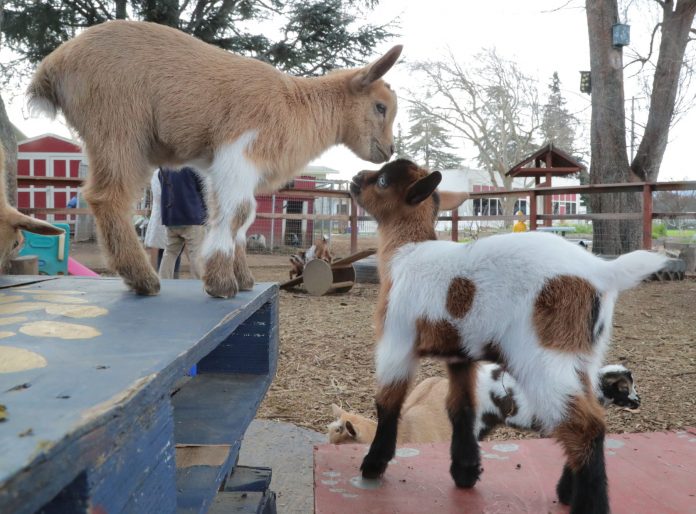When one of the Charter School of Morgan Hill’s Nigerian Dwarf goats gave birth to her litter on the campus farm in January, the animal’s handlers brought three newborn kids into the office for warmth and to get acquainted with their mother.
Unbeknownst to them, a fourth baby goat was left behind—one that would soon become a major part of the CSMH community.
Two hours after “Amber” had given birth, a teacher could hear what sounded like a baby crying under the school barn. A closer look and “Tanzi” was discovered.
“We’re thinking that the baby was the first to come out and crawled under to rest while mom gave birth to three more,” explained Kathy Funke, the school’s agricultural science teacher as well as a CSMH founding member.
But when the lost baby goat was brought inside to join its siblings, too much time had passed and Tanzi was rejected by her mother.
At first, Funke took it upon herself to care for Tanzi, bottle-feeding it and bringing it home in the evening. As word spread on campus, CSMH parents began to offer to do the same and soon a sign-up sheet to help with Tanzi was filled with families wanting to do their part.
Now, those who signed up get a chance to take Tanzi home, bottle-feed her store-bought goat’s milk, show her love and affection and log their adventures in a school journal.
“It’s been really fun for all the families,” said Funke, who has run the agricultural science program at the school, located on the Encinal campus north of Morgan Hill, for the last 13 years.
During the day, Tanzi joins her three siblings as well as the six other kids that were born to other CSMH adult goats between Jan. 12 and Jan. 26. The goats are the newest members to the campus farm, which also includes pigs and chickens.
Students embrace goats
“The kids have been learning everything from the birth process to nursing to gardening to just everything outdoors,” Funke explained. “We go for creek walks….We learn about environmental stuff.”
CSMH’s sixth grade class conducted an experiment of genetics where they attempted to predict the eye color of the baby goats based on who their parents are. Then, after the births, they backtracked and figured out which had the dominant genes for eye color.
“Students got to watch the birth (of the baby goats),” said Funke, who shows them how to castrate the animals and give them their shots. “It’s as real as we can make it.”
Tanzi, who is used as a “therapy goat” for any child having a hard time for whatever reason, and all the other baby goats have become the toast of campus. The livestock are housed in a fenced area and playground designed by the school’s kindergartners.
“It’s really cute and special because most schools don’t really have animals,” said 8-year-old Madison Larson, as she held a baby goat called “Tiger’s eye.”
For Isabella Lim, 9, it was not her first exposure to goats since her mother used to have them at their home.
“I like how they’re so playful and when they get tired they just fall asleep on your lap,” Lim shared.
The playfulness of the baby goats, as well as a chance to cuddle with them, makes for an especially fun 40-minute ag science class these days at CSMH.
“I like to hold them,” said 8-year-old Sam Schmidvauer. “They don’t always like to be held. They’re really fast.”
Third-grade classmate Samantha Bertoldi, 8, has taken Tanzi home with her and cherished the time spent caring for the baby goat. She said they bottle feed it with milk and have even changed its diaper.
“I like seeing all the babies and holding them,” Bertoldi said.
Veteran teacher Eva Swope, in her 13th year, watches over her students as they tend to the goats, shares information about the animals and asks questions for them to consider.
Learning to farm for food
“Number 1, they learn respect for nature and animals…The animals teach them responsibility and nurturing,” said Swope, who expanded on the entire ag science program and its importance to her students. “With the garden, the kids are willing to try all kinds of vegetables that they wouldn’t otherwise because they are helping to grow them.”
With the increase in goats, the goal is to milk them and make other foods out of the goat’s milk such as yogurt, cheese and ice cream, according to Funke. They already produce eggs from the chickens, which are sold with those proceeds going back into the farm, and veggies from the garden that are used in CSMH’s IronChef cooking class.
“It’s been a huge community builder,” said Funk of the CSMH’s newest members. “The goats love the kids and the kids love the goats.








